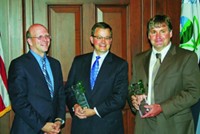Advertisement
Grab your lab coat. Let's get started
Welcome!
Welcome!
Create an account below to get 6 C&EN articles per month, receive newsletters and more - all free.
It seems this is your first time logging in online. Please enter the following information to continue.
As an ACS member you automatically get access to this site. All we need is few more details to create your reading experience.
Not you? Sign in with a different account.
Not you? Sign in with a different account.
ERROR 1
ERROR 1
ERROR 2
ERROR 2
ERROR 2
ERROR 2
ERROR 2
Password and Confirm password must match.
If you have an ACS member number, please enter it here so we can link this account to your membership. (optional)
ERROR 2
ACS values your privacy. By submitting your information, you are gaining access to C&EN and subscribing to our weekly newsletter. We use the information you provide to make your reading experience better, and we will never sell your data to third party members.
Environment
2011 Green Chemistry Awards
Honors: Recipients win praise for innovations that promote sustainability
June 27, 2011
| A version of this story appeared in
Volume 89, Issue 26

Eliminating 199 million lb of hazardous chemicals and solvents, saving more than 21 billion gal of water, and avoiding 57 million lb of carbon dioxide emissions: Those are a few of the annual benefits derived from the technologies implemented by the past 82 winners of the Presidential Green Chemistry Challenge Awards. Now, five new winners of this national award have been named. They were honored during a ceremony held on June 20 in Washington, D.C.

The competitive awards program, administered by the Environmental Protection Agency and sponsored in part by the American Chemical Society, recognizes efforts to incorporate the principles of green chemistry and green engineering into the design, manufacture, and use of chemical products and processes to help achieve federal goals for pollution prevention. This year’s winners, selected by a panel convened by ACS’s Green Chemistry Institute, described their technologies during lectures at the concurrent 15th Annual Green Chemistry & Engineering Conference.
Speaking during the ceremony, Paul T. Anastas, assistant administrator of EPA’s Office of Research & Development and one of the codevelopers of green chemistry, commented that establishing these awards at the presidential level 16 years ago was a signal that green chemistry is important. “Beyond simply giving credit for accomplishments where it is due, these awards serve as a model to companies and to scientists of what’s possible,” he said.
“The art of communicating that meeting environmental and economic goals simultaneously for societal benefit is possible is an essential role that you play,” Anastas told the award winners. “This innovation is our pathway to sustainability.”
Among the 2011 award winners is organic chemist Bruce H. Lipshutz of the University of California, Santa Barbara, who received the Academic Award for creating a low-cost designer surfactant that allows most common transition-metal-catalyzed organic reactions to be carried out in water at room temperature.
Industrial biotechnology firm BioAmber, which has headquarters in Plymouth, Minn., garnered the Small Business Award for developing a biosynthetic route to succinic acid at lower cost than existing petroleum-based routes.
Paints and coatings specialist Sherwin-Williams Co. won the Designing Greener Chemicals Award for creating a family of water-based acrylic alkyd paints using soybean oil and recycled polyethylene terephthalate as raw materials, which significantly reduces volatile organic compound emissions.
Industrial biotechnology company Genomatica, based in San Diego, took home the Greener Synthetic Pathways Award for inventing a low-cost microbial fermentation technology, which it is using to make the commodity chemical 1,4-butanediol from renewable carbohydrate feedstocks.
Houston-based Kraton Performance Polymers landed the award for Greener Reaction Conditions for developing a family of halogen-free, high-flow polymer membranes for more energy efficient water purification applications.
In congratulating the winners, ACS President Nancy B. Jackson said the awards, coupled with 2011’s designation as the International Year of Chemistry, give chemists a unique opportunity to convey several imperative messages to society. “These events allow us to raise awareness of chemistry and show the world how important our field of study is to the future of humankind,” she said. “They also facilitate our efforts in attracting younger people to become chemists.
“Finally, they allow us to show the general public how important chemistry is in solving global problems,” Jackson continued. “Steadily, we are inching forward toward a sustainable society because of this impressive research.”







Join the conversation
Contact the reporter
Submit a Letter to the Editor for publication
Engage with us on Twitter